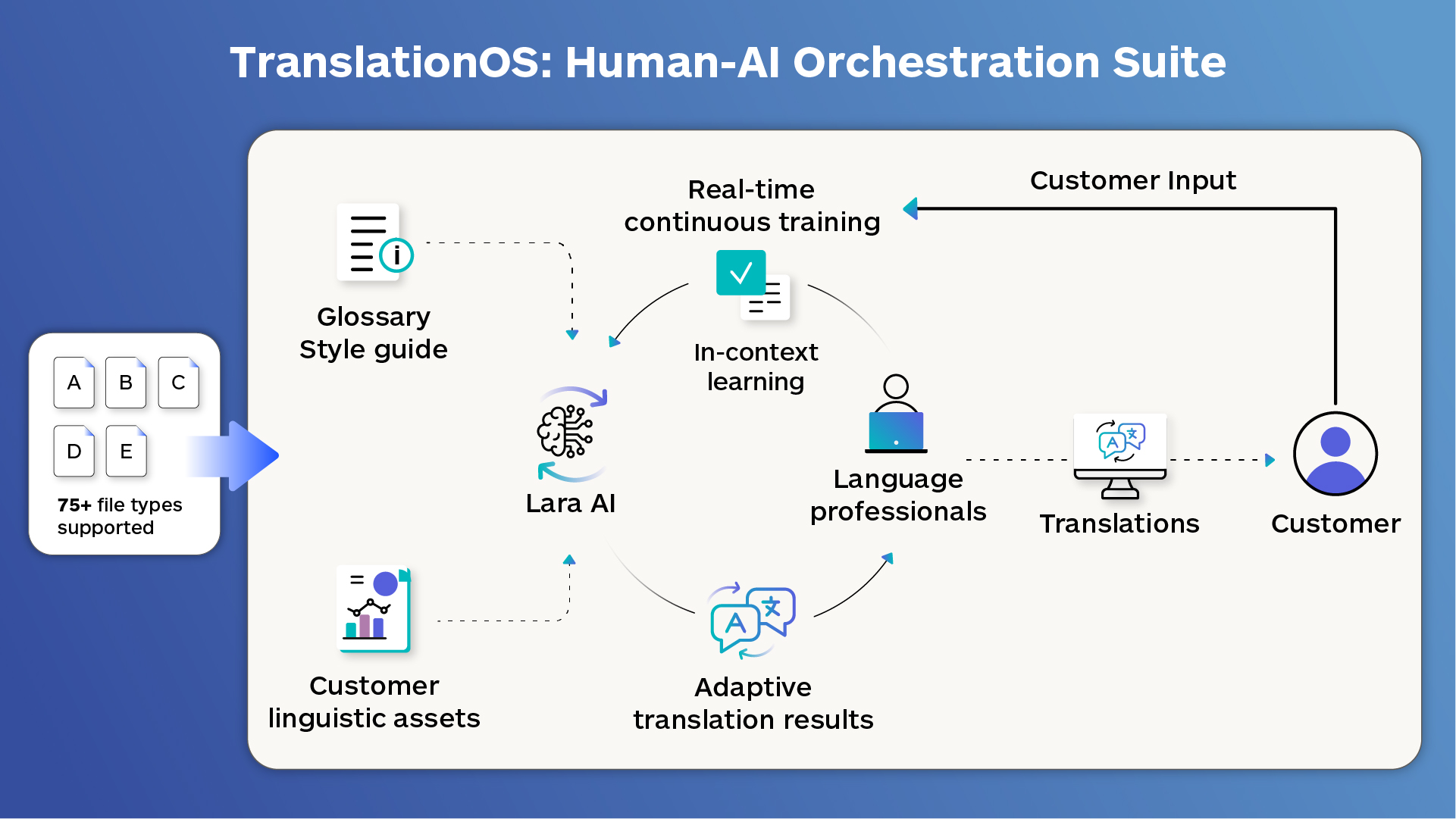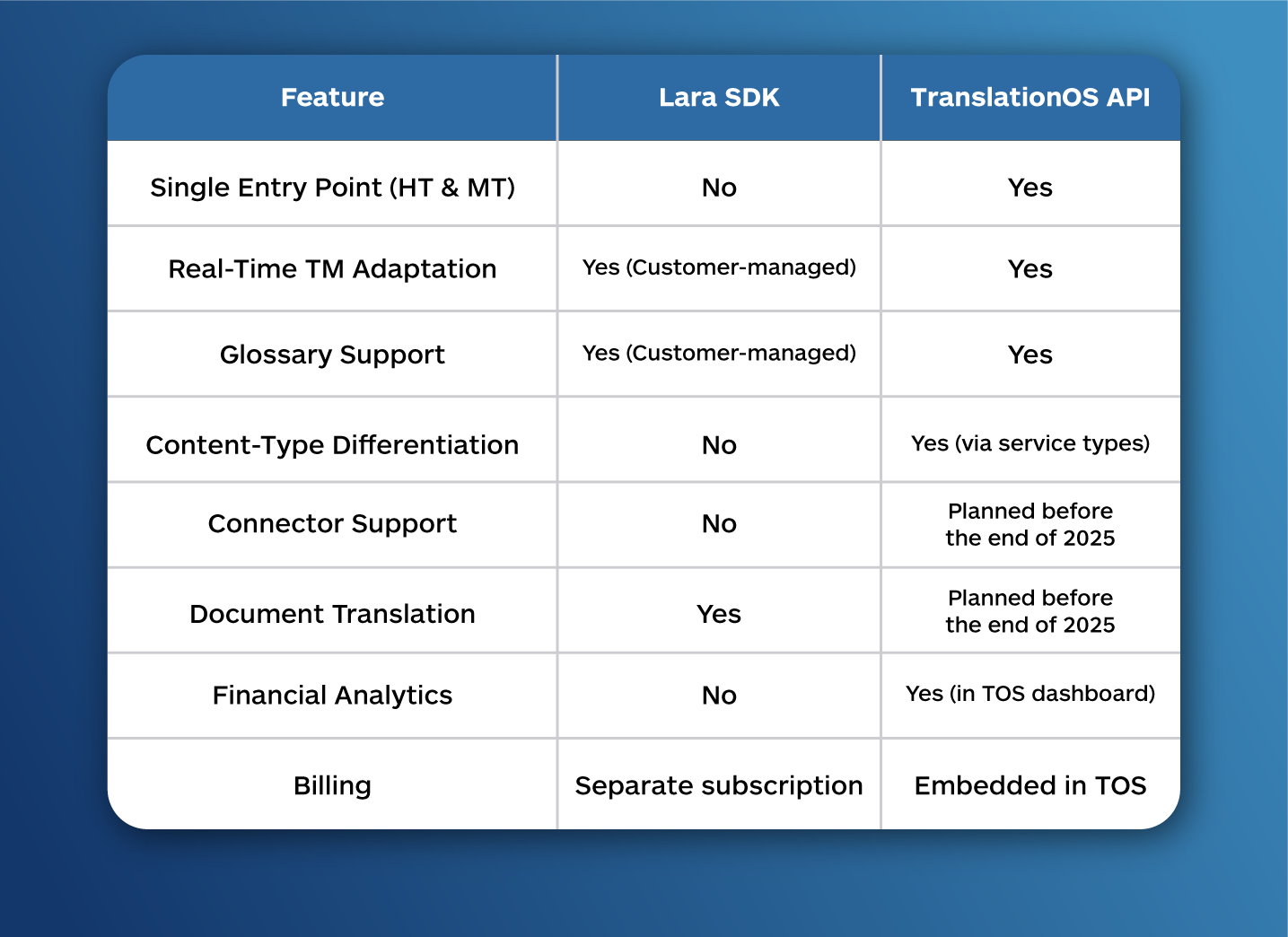Rome – October 9, 2025
Lara, Translated's proprietary Translation AI model, offers a powerful and adaptable solution for enterprise customers seeking to integrate high-quality translation into their workflows. By combining advanced AI with robust asset management and flexible integration options, Lara provides a scalable platform for both machine and human translation. This document outlines how enterprise clients can leverage Lara, detailing its integration models, core features, and operational procedures to achieve seamless and high-quality multilingual communication.
The Go-to-Market Strategy: Unification through TranslationOS
For enterprise customers, the primary and recommended integration path for Lara is through TranslationOS (TOS), Translated's comprehensive translation management platform. This go-to-market strategy is designed to provide a single, unified entry point for both Machine Translation (MT) and Human Translation (HT) services.
Integrating Lara via the TOS API offers several distinct advantages for an enterprise:
- Unified Account Management: It consolidates HT and MT into a single account, simplifying vendor management and oversight.
- Simplified Service Management: Workflows are managed through "service types," allowing for easy differentiation and routing of content.
- Integrated Financials: The platform provides a unified system for billing, financial visibility, and reporting, all accessible through the TOS dashboard.
- Future-Proof Compatibility:This model ensures ongoing compatibility with future developments, including new connectors and document translation features.
While the TOS API is the default path, an alternative exists for specific, demanding use cases. The Lara Software Development Kit (SDK) offers direct API access to the MT engine. This path is reserved as a fallback option for clients with requirements for ultra-low latency or exceptionally high-volume loads that cannot be met by the standard TOS integration. However, the SDK path requires the customer to manage linguistic assets directly and involves a separate billing process, making the TOS API the more streamlined and feature-rich choice for most enterprises.

Core Services and Workflows
Through TOS, enterprise customers can seamlessly route translation requests for either machine or human processing. The routing is determined by the API endpoint used and the selected service type.
- Machine Translation (MT): For instant translation of plain text or documents, customers use the translateai endpoints. The flow is straightforward: the customer sends the request to TOS, which routes it to Lara for immediate translation and returns the output. This process does not involve human intervention. Lara officially supports 30 languages with full features like context and glossary support, and unofficially supports around 200 languages with more limited functionality.

- Human Translation (HT): When human review is required, requests are sent to the translate endpoint. TOS routes these jobs through Matecat, Translated's professional CAT tool, where they are handled by human translators before delivery. This ensures that content requiring nuance and cultural adaptation receives expert attention.
Enhancing Translation Quality with Linguistic Assets
Lara's true power lies in its ability to adapt and learn from a customer's specific linguistic assets. Lara does this while ensuring data security and privacy. Proper management of these assets is key to maximizing translation quality and consistency.
Translation Memories (TMs)
TMs are databases of previously translated segments (source and target text pairs). Lara uses them to ensure consistency and improve the accuracy of future translations.
- Association and Synchronization: TMs can be associated with a Lara account either manually by the Lara engineering team during setup or automatically via Matecat. When a customer uses both HT and MT pipelines in TOS, Matecat continuously synchronizes and updates TMs with Lara. Every confirmed translation in a Matecat project updates the TM in real time, allowing Lara's MT output to continuously adapt.
- TM Cleanup: To prevent poor-quality data from degrading MT output, Lara incorporates a sophisticated, automated cleaning process. Before import, TMs are filtered to remove empty lines, overly long segments, corrupted characters, and segments with mismatched languages. The process also normalizes Unicode characters and malformed XML to ensure the data is clean and reliable. For customers requiring even higher quality, an advanced semantic similarity scoring process can be applied to flag and either discard or correct low-quality segments.
- Adaptation Behavior: In the HT pipeline, Lara adapts to TMs active in "Lookup" mode within Matecat. In the MT pipeline, adaptation is governed by the TMs linked to the Lara account and the specific service type configured in TOS.
Glossaries
Glossaries ensure that specific brand terminology, product names, and defined terms are translated consistently.
- Capabilities: Lara's glossaries are case-insensitive and can handle verb tenses, plural forms, and idiomatic expressions. They are unidirectional, translating from a specified source to a target language.
- Management and Association: Unlike TMs, glossaries are not automatically synchronized. They must be manually associated with a Lara account by the engineering or operations team and linked at the service type level. Importantly, glossaries cannot be shared across different Lara accounts.
- Best Practices: Glossary terms are given priority over TM matches of 99% or lower. This means they must be used with care to avoid unintended translations. The recommended best practice is to prefer TM adaptation over glossary adaptation, as TMs provide richer context, greater flexibility, and more reliable consistency . Quality Managers (QMs) should validate all glossaries to ensure they meet Lara's requirements and will not degrade MT quality.
Context, Instructions, and Style
For even finer control over translation output, customers using the translateai API can use several fields:
- Context: This feature allows users to provide text strings that are relevant to the translation but should not be translated themselves (and are not billed). This helps the engine make more accurate lexical choices.
- Instructions: Customers can provide specific style guide rules directly in the API request, such as "Use a formal tone in Italian." This is a powerful way to enforce brand voice.
- Style: A style field can be set to "faithful," "fluid," or "creative." However, the "creative" style can produce unpredictable results and is generally not recommended for enterprise clients, who should rely on TMs, glossaries, and instructions for influencing output
Onboarding and Billing
The activation process is designed to be straightforward, with clear steps for both the customer and Translated's internal teams.
- Lara via TOS (Default Path): Translated initiates the process by creating a customer-specific Lara account, generating API keys, and configuring the necessary HT and MT service types in TOS. The customer then uses the provided TOS API key to call the correct endpoints (translate for HT, translateai for MT) with the assigned service types.
- Instructions: Customers can provide specific style guide rules directly in the API request, such as "Use a formal tone in Italian." This is a powerful way to enforce brand voice.
- Lara via SDK (Exception Path): The customer registers for an account on the Laratranslate.com website and shares the registration email with Translated. Translated then completes the backend setup for billing and associates any existing TMs. The customer integrates the Lara SDK directly into their application.
Billing is directly tied to the integration model. In the recommended TOS path, MT character counts and costs are tracked in real-time and are visible in the TOS dashboard, with breakdowns by service type planned for the future. HT costs are included in the per-word rate for human translation. For the SDK path, billing is handled via a separate subscription, with total monthly consumption aggregated into a single line item without detailed reporting in TOS.Lara-for-Enterprise-Customers.docx